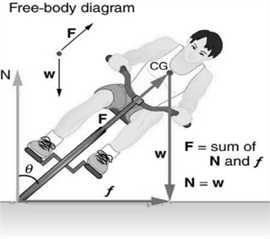Part of riding a bicycle involves leaning at the correct angle when making a turn, as seen in Figure. To be stable, the force exerted by the ground must be on a line going through the center of gravity. The force on the bicycle wheel can be resolved into two perpendicular components—friction parallel to the road (this must supply the centripetal force), and the vertical normal force (which must equal the system’s weight).
(a) Show that\(\theta \)(as defined in the figure) is related to the speed v and radius of curvature r of the turn in the same way as for an ideally banked roadway—that is,\(\theta = {\tan ^{ - 1}}\,{v^2}/rg\)
(b) Calculate \(\theta \) for a \(12.0{\rm{ m}}/{\rm{s}}\) turn of radius \(30.0{\rm{ m}}\) (as in a race).

Figure 6.36 A bicyclist negotiating a turn on level ground must lean at the correct angle—the ability to do this becomes instinctive. The force of the ground on the wheel needs to be on a line through the center of gravity. The net external force on the system is the centripetal force. The vertical component of the force on the wheel cancels the weight of the system while its horizontal component must supply the centripetal force. This process produces a relationship among the angle \(\theta \), the speed \(v\), and the radius of curvature \(r\) of the turn similar to that for the ideal banking of roadways.


